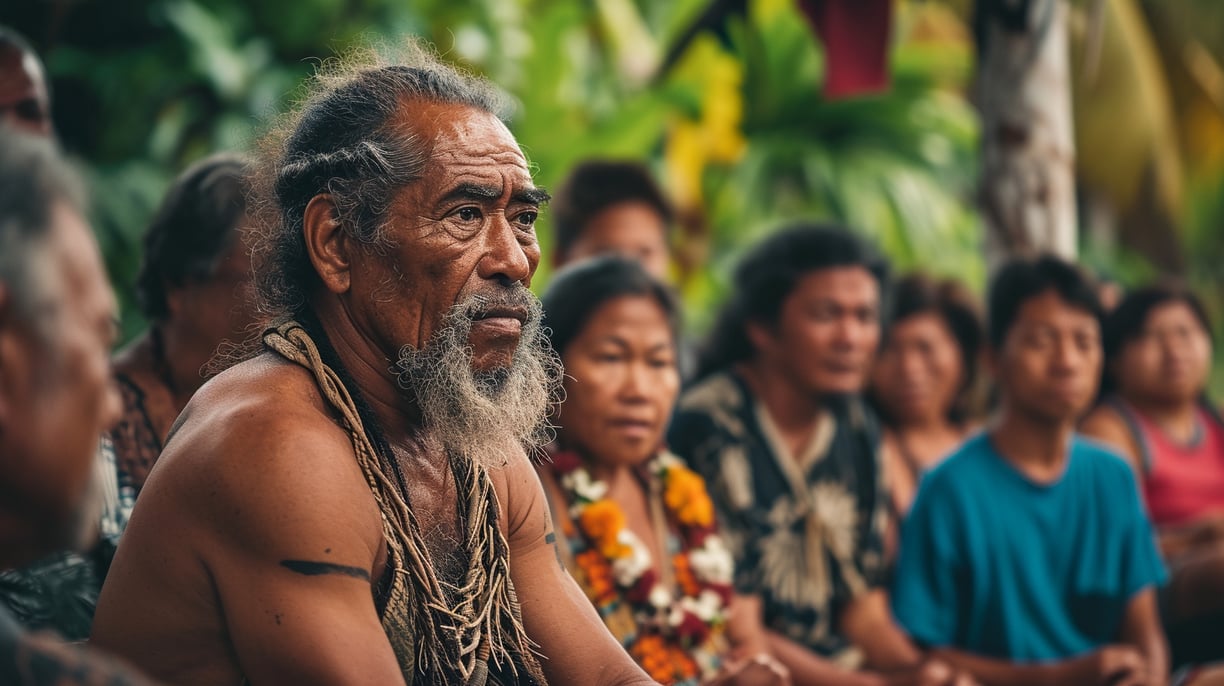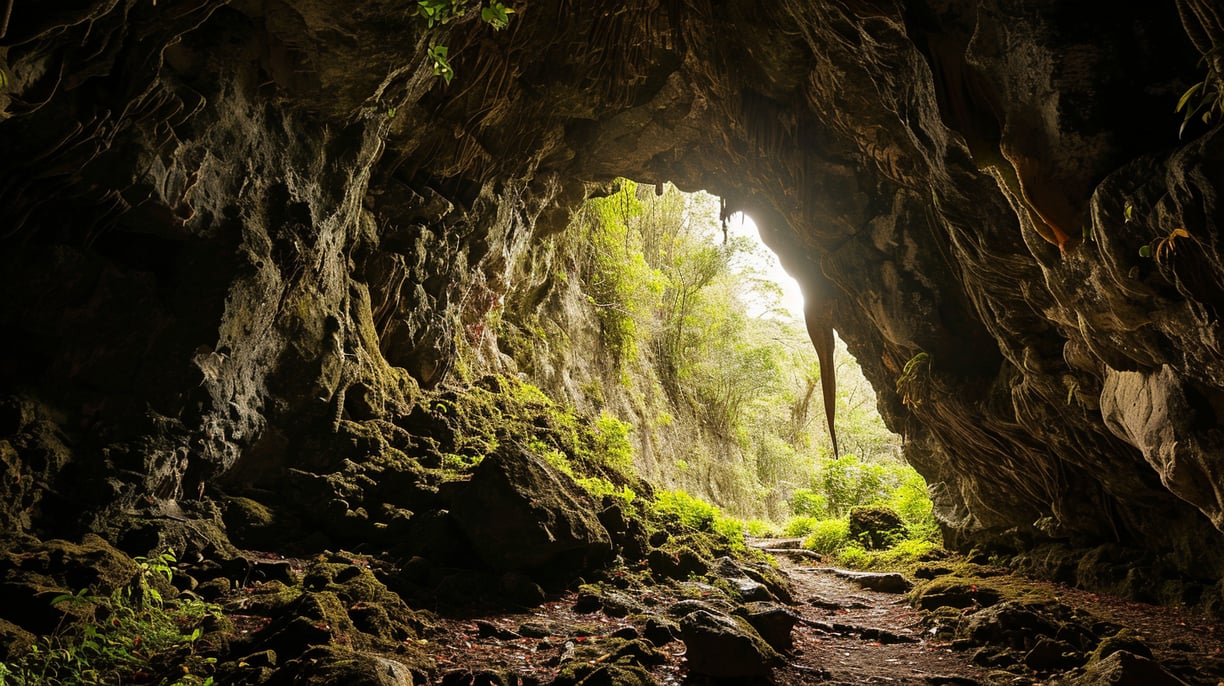Journey Through Time: The Fascinating History of Mangaia Island
Embark on a historical odyssey through Mangaia Island, where ancient legends and geological wonders intertwine, offering a unique glimpse into the rich tapestry of the Cook Islands' past.

Located in the Cook Islands, Mangaia Island is a place of rich history and captivating tales. From its ancient origins to its modern-day blend of old and new, this small island has undergone a remarkable journey through time. Let us embark on a fascinating exploration of Mangaia's history, from its geological formation to its preservation of cultural heritage.
The Ancient Origins of Mangaia Island
Geological Formation and Early Inhabitants
Mangaia Island, located in the South Pacific, is believed to have emerged from the deep Pacific Ocean around 18 million years ago. Its formation was shaped by volcanic activity, resulting in a unique limestone landscape that is a testament to the island's tumultuous past. The island's earliest inhabitants were brave seafarers from Southeast Asia, who ventured across vast distances to settle here over 1,000 years ago.
These early settlers, known as the Polynesians, brought with them a rich cultural heritage that would shape the identity of Mangaia for centuries to come. Navigating by the stars and relying on their deep understanding of the ocean currents, these seafarers embarked on perilous journeys to reach the island. Their arrival marked the beginning of a new chapter in Mangaia's history.
Upon their arrival, the Polynesians discovered a land teeming with life and abundant resources. The island's fertile soil and favorable climate allowed them to develop sophisticated agricultural practices, cultivating crops such as taro, yams, and bananas. These crops not only provided sustenance for the island's inhabitants but also played a crucial role in the island's economy and trade networks.
One particular plant that thrived in Mangaia's fertile soil was the noni fruit. This tropical fruit, known for its medicinal properties, became a staple in the islanders' diet and played a significant role in their traditional medicine practices. The noni fruit, with its distinct aroma and taste, became a symbol of Mangaia's unique biodiversity and the resourcefulness of its people.
The Role of Mythology in Mangaia's History
Mythology played a crucial role in shaping the history of Mangaia Island. The island's oral traditions are filled with stories that have been passed down from generation to generation, preserving the island's rich cultural heritage. These tales speak of ancient gods and heroes, describing epic battles and remarkable feats that have become an integral part of the island's identity.
One such story is the legend of Ina, a powerful female deity who is believed to have played a vital role in the creation of Mangaia. According to the legend, Ina emerged from the depths of the ocean, bringing with her the gift of life and fertility to the island. She is revered as the mother of all living things on the island and is often depicted as a symbol of strength and resilience.
The legend of Ina is not only a tale of creation but also a story of love, loss, and triumph. It tells of Ina's adventures and struggles as she navigates the challenges of the island, battling mythical creatures and overcoming obstacles. Her story serves as a source of inspiration for the people of Mangaia, reminding them of the importance of perseverance and the power of the human spirit.
Throughout the centuries, the mythology of Mangaia has continued to evolve, with new stories and legends being added to the island's rich tapestry of folklore. These stories serve as a reminder of the island's ancient origins and the resilience of its people, who have thrived in the face of adversity for thousands of years.

The Arrival of Polynesian Settlers
Cultural Impact and Developments
Between the 11th and 14th centuries, Polynesian settlers arrived on Mangaia Island, further shaping its history and culture. These newcomers brought their language, customs, and traditions, blending them with the existing cultural fabric. Over time, a distinct Mangaian culture emerged, enriched by the influences of both Southeast Asia and Polynesia.
The society on Mangaia Island was organized into matrilineal clans, with each clan having its own chief. Traditional practices such as tattooing and intricate wood carvings flourished, showcasing the artistic talents of the island's inhabitants.
The arrival of Polynesian settlers not only brought new customs and traditions but also introduced a wealth of knowledge and skills to the island. They brought with them advanced agricultural techniques, allowing the Mangaian people to cultivate a wider variety of crops and improve their overall food security. The settlers also introduced new fishing methods, enabling the islanders to access previously untapped resources from the surrounding ocean.
Furthermore, the Polynesian settlers had a profound impact on the spiritual beliefs of the Mangaian people. They brought with them their own deities and religious practices, which merged with the existing spiritual beliefs of the island. This fusion created a unique and vibrant religious landscape, with rituals and ceremonies that celebrated the interconnectedness of the natural world and the divine.
The Evolution of Traditional Practices
As time passed, traditional practices on Mangaia Island evolved, reflecting both external influences and internal developments. Contact with European explorers and missionaries introduced new ideas and technologies, leading to adaptations and changes within the community.
For example, European contact sparked an interest in Western-style clothing, while traditional practices, such as tattooing, gradually faded. The islanders began to adopt European clothing styles, incorporating them into their daily lives and special occasions. This cultural exchange not only changed the islanders' appearance but also influenced their sense of identity and self-expression.
Despite the changes brought about by European contact, the legacy of Mangaia's unique cultural heritage remained deeply rooted in the island's identity. The traditional practices that once flourished continued to be celebrated and preserved through stories, songs, and dances passed down through the generations. These cultural expressions served as a reminder of the island's rich history and the resilience of its people.
Moreover, the arrival of European explorers and missionaries also brought advancements in education and technology to Mangaia Island. Schools were established, providing the islanders with access to formal education and new opportunities for personal and intellectual growth. The introduction of modern technologies, such as printing presses and improved transportation systems, connected the island to the wider world, facilitating the exchange of ideas and fostering economic development.
In conclusion, the arrival of Polynesian settlers on Mangaia Island had a profound and lasting impact on its history and culture. The blending of Polynesian and Southeast Asian influences created a unique cultural tapestry, while the evolution of traditional practices showcased the islanders' ability to adapt and embrace change. Through the passage of time, Mangaia Island has continued to thrive, preserving its rich heritage while embracing the opportunities of the modern world.

European Discovery and Colonization
Initial Encounters and Impressions
In the late 18th century, European explorers stumbled upon the shores of Mangaia Island, forever changing its trajectory. Captivated by the island's natural beauty and indigenous peoples, European travelers documented their encounters and left behind lasting impressions.
Accounts of their visits paint a picture of a place untouched by outside influences, with pristine landscapes, lush forests, and crystal-clear lagoons. The island's inhabitants, known for their warmth and hospitality, left a lasting impression on the early European visitors.
Changes in Governance and Society
The arrival of European colonizers in the 19th century marked a significant turning point in Mangaia's history. The Cook Islands, including Mangaia, became a British protectorate in 1888, bringing about changes in governance and society.
The impact of colonization led to the adoption of a Western-style administration, education system, and legal framework. As the island adapted to colonial rule, the people of Mangaia faced both challenges and opportunities, striving to maintain their cultural identity while embracing change.
Mangaia Island in the 20th Century
Impact of World Wars on Mangaia
Like many other Pacific islands, Mangaia was not immune to the effects of World Wars I and II. The island saw young men leave to join the military, leaving a significant impact on the local community. While some returned home as heroes, others never came back, leaving a lasting void.
The wars also brought external influences and modern technologies to the island. Improved transportation and communication allowed for increased interactions with the outside world, reshaping the island's social and cultural landscape.
Progress Towards Independence
In the latter half of the 20th century, the people of Mangaia began striving for greater self-governance and independence. As part of the Cook Islands, the island made significant progress towards achieving self-rule. Today, the Cook Islands is in free association with New Zealand, enjoying a unique status that allows for self-determination and cultural preservation.
Modern Mangaia: A Blend of Old and New
Preservation of Cultural Heritage
Despite the influences of globalization and modernization, Mangaia Island has maintained a strong commitment to preserving its cultural heritage. Efforts have been made to document and revive traditional practices, ensuring that cultural knowledge and skills are passed on to future generations.
Art forms such as carving, weaving, and traditional dances continue to be celebrated, providing a glimpse into the rich history and cultural fabric of the island. Visitors have the opportunity to experience the warmth of Mangaian hospitality and witness the vibrant expressions of its cultural traditions.
Mangaia in the Contemporary World
Mangaia Island has embraced the contemporary world while holding steadfast to its cultural roots. Tourism has brought economic opportunities and increased connectivity, allowing the island to share its stories and traditions with a global audience.
As you journey through diverse landscapes and engage with the island's people, you will be captivated by the fascinating history of Mangaia Island. From its ancient origins to its modern-day vibrancy, every step unveils the compelling narrative of this small yet remarkable place in the heart of the Pacific.
Conclusion
As you conclude your journey through Mangaia's captivating history, you may find yourself inspired to reclaim your own roots and explore the unique stories that shape your own identity. Take a moment to reflect on the power of preserving cultural heritage, ensuring that our collective history continues to inspire future generations.
Whether you have the opportunity to visit Mangaia Island or simply dive deep into its fascinating history from afar, let the tale of this enchanting place serve as a reminder of the beauty and resilience of human cultures. Explore the world around you, seek out the stories that remain untold, and let the past guide you towards a richer, more interconnected future.